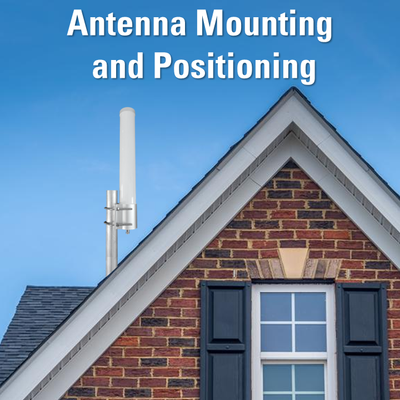Antenna Mounting Height and Positioning: How It Impacts Signal Strength
Posted by Gordon Reed on 12th Aug 2025
When it comes to wireless performance, the type of antenna you choose is only part of the equation. Mounting height and positioning can make the difference between a weak, unstable connection and optimal signal quality. Antenna placement directly impacts how effectively the antenna can “see” the signal source, avoid interference, and deliver a strong connection.
At AntennaGear, we focus on designing antennas that perform at their peak when installed correctly. In this blog, we’ll explain why height and positioning matter and share best practices to ensure you get the most out of your antenna.
Why Mounting Height Matters
Height plays a critical role because radio waves travel best when there’s a clear, unobstructed path between the antenna and the signal source.
- Line-of-Sight (LoS): Higher antennas can avoid common obstructions like walls, trees, and nearby buildings that weaken or block signals.
- Fresnel Zone Clearance: Beyond direct LoS, antennas need a clear Fresnel zone—a 3D elliptical area around the LoS path where obstructions can cause diffraction and signal loss. Raising your antenna helps reduce interference in this zone.
- Improved Signal-to-Noise Ratio: By getting the antenna above ground-level noise sources, you can significantly reduce interference and achieve cleaner signal reception.
Example: A rooftop-mounted 4G or 5G antenna can deliver noticeably better performance compared to one placed indoors, even if both are high-gain models.
Positioning and Orientation
Azimuth and Elevation
For directional antennas (e.g., Yagi or panel designs), aiming is crucial. Antennas must be pointed toward the nearest cell tower or access point to maximize gain and minimize wasted energy.
Polarization Alignment
The orientation of your antenna must match the polarization of the transmitting source. For instance, a vertically polarized antenna should remain upright; tilting or rotating it off-axis can lead to severe signal losses.
Avoiding Obstructions
Large trees, metal siding, or nearby concrete walls can block or reflect radio waves. Positioning your antenna above or away from these obstacles ensures better line-of-sight and reduces multipath interference.
Height vs. Cable Loss
It’s tempting to place an antenna as high as possible, but longer coaxial cables introduce signal attenuation. Using low-loss cable or keeping cable runs short is essential to balance height and performance.
Environmental Factors
- Multipath Propagation: In dense urban areas, signals reflect off glass and metal surfaces, arriving at the antenna at different times and polarizations. Proper placement and cross-polarized antennas can minimize these effects.
- Weather and Seasonal Changes: Rain, snow, or even wet leaves can absorb or scatter radio waves, reducing signal strength. Seasonal foliage changes can also affect performance.
- Electromagnetic Interference (EMI): Power lines, electrical panels, or other antennas can introduce noise. Positioning your antenna away from these sources ensures better clarity and stability.
Best Practices for Mounting
- Use Quality Mounting Hardware: Choose non-metallic mounts where possible to reduce reflection and interference. Pole and wall mounts are excellent for outdoor setups.
- Raise Above Roofline: Outdoor antennas should typically be placed above the roofline to achieve clear line-of-sight.
- Grounding and Surge Protection: Elevated outdoor antennas are susceptible to lightning strikes. Use surge protectors and proper grounding for safety and equipment protection.
- Test Before Finalizing: Temporarily mount the antenna and test signal strength before permanent installation. Small adjustments in angle or height can produce big performance gains.
Common Mistakes to Avoid
- Mounting Too Low: Keeping an antenna behind walls, fences, or clutter can severely limit its coverage.
- Overly Long Coaxial Runs: Using low-quality or excessively long coaxial cable can negate the benefits of higher mounting by introducing insertion loss.
- Incorrect Polarization: Rotating an antenna incorrectly (e.g., horizontal when it needs vertical) can cause up to 20 dB of signal loss.
- Crowding Antennas: Placing antennas too close together can cause coupling, detuning, or interference.
AntennaGear Solutions
AntennaGear offers a wide range of antennas designed for flexible placement and optimal performance, including outdoor-rated models that are weatherproof and UV-resistant.
- Rooftop Solutions: Antennas with mounting kits and heavy-duty brackets designed for line-of-sight deployments.
- Magnetic Mounts: Perfect for mobile and temporary setups like RVs and field operations, also eliminating the need for drilling or glueing to mount the antenna.
All AntennaGear products undergo stringent VNA testing to ensure they meet or exceed performance standards, giving you confidence that proper placement will deliver peak results.
What This Means for You
Mounting height and positioning are often overlooked but are critical factors for antenna performance. By understanding the principles of line-of-sight, polarization, and cable management, you can greatly enhance your signal strength and reliability.
Explore AntennaGear’s range of mounting-ready antennas and accessories to unlock the full potential of your wireless setup.

